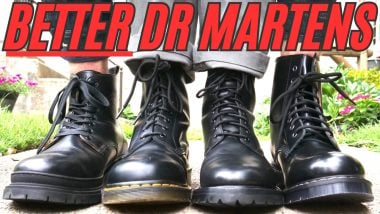Interview With Sagara, Indonesia’s Best Known Bootmaker
Anyone who has spent a lot of time reading about the world’s best boots has no doubt come across one exceptional country over and over again: Indonesia. We know about American, Italian, French, and Dutch bootmakers, but when looking for boot hubs outside of Europe and the U.S., Indonesia consistently appears at the top of the list. Why Indonesia?
It has a lot to do with the fact that the region was previously known as the Dutch East Indies, when the Netherlands ruled over the much of what is now called Indonesia. The Dutch went there to export spices and cash crops, but they imported a tradition of hardy leather footwear that took root and continued growing long after Holland pulled up their anchors and the world’s most populous Muslim nation declared independence in 1945.
Successful Indonesian boot companies include Santalum, Jalan Sriwijaya, Winson, Txture, and Junkard, but Sagara has perhaps the best reputation. Stridewise sat down with Bagus Satriow, the founder and CEO of Sagara Boots, to learn a little more about the brand.
Stridewise: Thanks for chatting, Bagus! My first question is about the company’s background, can you give us a more detailed history of how all these Indonesian boot companies came to be?
The history of shoemaking in Indonesia started around 1910s/1920s when our people established a shoe making company. Before, Indonesians wore traditional shoes and sandals. Then, most of that shoe company’s artisans went out on their own and started their own shoe workshops.
Until 1970, Cibaduyut (an area in Bandung, the country’s third most populous city – ed) was widely known as the longest shoes crafting street in Asia, and handwelting was widely used. However, a spirit of entrepreneurship in the 1990s led to youths starting their own apparel brands, which rose alongside the local music scene.
In 2008-2010, the second wave of local production happened, but it was a little different. There was a broader variety of companies being started, and some young people became focused on creating higher quality goods than the mass produced goods that had become common. So since that time period, many new shoe or boot makers have arisen in Indonesia.
SW: What are some of the challenges of making boots in Indonesia?
The biggest challenges of making boots in Indonesia are taxes and the high shipping cost, especially for small to medium sized businesses, since tax and high shipping costs add another extra amount to the selling price.
Then there’s the mindset that ASEAN (the Association of South-East Asian Nations – ed) countries only produce low quality products. That’s another challenge for getting the international market trust in the product.
Sourcing materials, too. Since most of their business are offline, we have to search for them by asking around to get the information on suppliers by word of mouth.
Lastly, most of the big manufacturers are inclined to be uncooperative with small to medium businesses because of our small quantity demand.
SW: OK, so what are some of the upsides of being located in Indonesia?
Low labor cost, living cost, and the fact that we’re largely an agrarian country are the benefits of being located in Indonesia. For instance, $1 – $2 is enough to get a meal per person in Bandung, Indonesia.
Indonesia also has strong craftsmanship heritage in which made us an underdog crafts exporter. Nevertheless, the underdog always carries a high spirit.
[Read my interview with another great Indonesian boot company, Santalum.]
SW: Where is Sagara’s leather sourced?
Most of our leather is sourced domestically, but we also sourced some of them from the best-known tanneries in the world. We cooperated with Shell Cordovan from Italy to make Hatch Grain leather, and our leather sole is sourced from South America.
SW: Are Sagara’s boots really hand-made and hand-welted?
Yes, all of our shoes and boots are handmade and handwelted since our vision is to preserve the shoemaking craft, that’s why we do not have a big machine.
SW: Do you draw more inspiration from European or American boot styles?
Sagara draws more inspiration from American boot styles in which the characteristic of the people and style represent their freedom. Thus in our opinion, American style fits best to Indonesian people with their similar characteristics.
SW: What shoemaker do you most admire?
There are a lot of great shoemakers in the world. First, we adore how Maison Corthay gave a twist on classic shoes. Secondly, we admire Yohei Fukuda’s neat work and how he puts Japanese spirit on his work and we can strongly feel it. The dedication of Marcell Mrsan to maintain this tradition by sharing his knowledge is no exception and lastly, Goto-san from White Kloud with his crazy outsole finishing, he makes rugged profile work boots that are tough as nails, but he finishes it very shiny like a high end bespoke shoemaker.
SW: Are most of your customers in Indonesia or elsewhere?
Most of our customers are Indonesia and some of them are American, British, Singaporean, and Australian, thanks to the online platforms that help us slowly gain more awareness worldwide.
SW: Hopefully, we can help introduce a few more people to your brand. Thanks for your time, Bagus!
See more of Sagara’s selection on their official website.
Featured image via @sagarabootmaker on Instagram.










Keep this going please, great job!
One of the few remaining makers of handsewn moccasin construction shoes in what was once a state bursting with them (Maine), Rancourt makes a vast range of predictably fantastic boat shoes, ranger mocs, penny loafers, some very nice dress shoes—and of course boots. While their welted boots are quite handsome indeed, this is a handsewn company, and their new low-slung Acadia chukka is a fantastic example of one. It’s more than a shoe, slightly less than a standard boot, and, very, very cool in the flint kudu leather (which I couldn t get a great photo of—the natural Chromexcel leather model is shown above).
Yes, Rancourt have been on my to-buy list for a very long time! I keep putting them on the backburner but certainly I’d love to try them out, the moc toes from them and quoddy and yuketen are very famous.